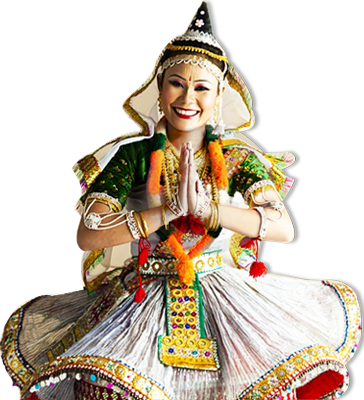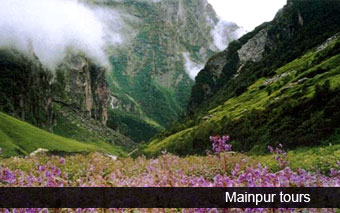
 Mostly visited for – Imphal (capital and cultural center of Manipur), Kaina (a small hillock sacred to Hindus), Churachandpur (largest district of Manipur), Tamenglong (known for hill range and narrow valleys), Khwairamband Bazar (main market of Manipur operated by women), Mainpur Zoological Garden (6 km. from Imphal), Ukhrul, Loktak Lake (famous for fumdis or floating islands), Langthabal, Moirang, Manipur State Museum
Mostly visited for – Imphal (capital and cultural center of Manipur), Kaina (a small hillock sacred to Hindus), Churachandpur (largest district of Manipur), Tamenglong (known for hill range and narrow valleys), Khwairamband Bazar (main market of Manipur operated by women), Mainpur Zoological Garden (6 km. from Imphal), Ukhrul, Loktak Lake (famous for fumdis or floating islands), Langthabal, Moirang, Manipur State Museum
Adventure - Trekking, Polo and Archery
Major Cities – Imphal, Churachandpur, Bishnupur, Ukhrul, etc
Weather - Summer: March to May, Monsoon: June to September, Post Monsoon: October to November, Winter: December to February. Climate of Manipur depends upon the altitude of hill ranges and varies from tropical to sub-alpine.
Connectivity
By Air - The state has an airport in its capital Imphal, which is well connected with Indian cities like Delhi, Kolkata and Guwahati.
By Rail – Manipur does not have any train service. But there are other north-eastern cities like Guwahati, Dimapur, Silchar which have always stations and are serviced by important trains to and from the rest of the country.
By Road - The road network is quite efficient in Manipur. National Highway 39 connects Manipur with major cities like Guwahati, Dimapur, Kohima, Silchar in the north-eastern part on India.
History, Geography and Culture of Manipur
The bejewelled state of Manipur is inherently blessed with classical natural wonders in the form of its heritage, culture, customs and life. The earliest reference of Manipur can be sourced out from the beginning of the Christian era. During 33 AD, Pakhangba, the first king of Manipur was coronated which led to the establishment of the state as a kingdom. The ruins of Kangla Palace in Imphal reinstate the fact that the region around Myanmar used to be a kingdom. This most historical and archaeological site in Manipur also saw the evolution of the region as a formidable capital city of Meitei rulers.
Another important chapter in the history of Manipur is its historic role during the Second World War. Moirang, a town in Manipur was the headquarter of Indian National Army (Azad Hind Fauj) during this war and this region rose to prominence due to flag hoisting ceremony on 14th April 1944 under the leadership of a noted Indian freedom fighter Netaji Subhas Chandra Bose. This is also special because it was the first time that the Indian tricolour was hoisted in the country. Here, one can still find the memorial dedicated for this remarkable event.
 Geographically located on the eastern frontiers, Manipur is bordered by Myanmar (Burma) on the east, Nagaland on the north, Assam on the west and Mizoram and Myanmar on the south. The physical features of Manipur mainly comprise the valley tucked between the blue hills on all sides. Covering 9/10th of the total area, these hills adorn the valley and provide this state a pristine charm. The rivers of Manipur include Barak, Imphal and Iril.
Geographically located on the eastern frontiers, Manipur is bordered by Myanmar (Burma) on the east, Nagaland on the north, Assam on the west and Mizoram and Myanmar on the south. The physical features of Manipur mainly comprise the valley tucked between the blue hills on all sides. Covering 9/10th of the total area, these hills adorn the valley and provide this state a pristine charm. The rivers of Manipur include Barak, Imphal and Iril.
The bejewelled land is equally exciting in terms of flora and fauna. Around 67% of the geographical area in Manipur is covered by the hill tract forest cover featuring pine trees. The endowed forest cover is also a host of rare and endemic plant and animal life.
Similarly, the state is known for its rare and precious blooms. Over 500 orchid species bloom in Manipur, making it a flora rich state. Out of animals, Sangai dancing deer is the most famous in the state. Hornbills also comprise the rich fauna of Manipur besides hoolock gibbon, sloe loris, spotted linshang, clauded leopard, pheasant, blyths tragopan, burmese pea-fowl, etc.
The culture of Manipur is equally exciting and enthusiastic. Theatre, folk and cultural performances illustrate the spirit of the state, allowing it to be in the mainstream everytime. The classical Manipuri dance form featuring Rasa leela, inspired by the love of Krishna and Radha forms an essential element of the state’s rich culture. Besides this, the state is also famed for the origins of Polo.
Wildlife Sanctuaries
Keibul Lamjao National Park (Manipur), Manipur Zoological Garden (6km from Imphal)
Religion – Meiteism (Meeteism) and Sanamahi, Hinduism, Christianity, Islam
Festivals
Yaoshang Festival (Feb/Mar)
Cheiraoba Festival (Apr)
Kang Festival (July)
Kut Festival
Ramazan-Eid
The Festival of Manipuri Muslims
Heiku Hidongba (Sept)
Ningol Chakouba Festival (December)
Lui-Ngai-Ni (15th Feb) (Dec/Jan)
Kut (1st Nov)
Eat – The local cuisine of Manipur mainly features the extensive use of rice and meat, traditionally eaten by sitting on the floor, with Banana leaves used as plates. Local specialties here include Ngri (roasted and fried fish), Kobok (roasted rice and molasses dessert), Yongchak singju, Monica gi chakum, Aloo mattar and smoked fish, Bora (A kind of pakora), Khajing bora and Kanghau.
Buy – Handlooms are a way of life and almost every home has at least one loom. The crafts form a rich interpretation of Manipur’s heritage that can be taken back by tourists as souveniers. Famous among distinctive arts and crafts of the state feature Cane and Bamboo (Utilities), Wood Carving (Wooden Tray, Spoon and Drum etc.), Textile Weaving, Dolls and Toys, Stone-Carving (Bowls, Candle-stands, Grinders, Flower-vases, Plates, etc.), Block Printing (Printing on Pillow-covers, Towels and Bed-sheets), Kauna (Water Reed), Mat (Mats and Cushion) and Hand-Embroidery fabrics.
Hotels – Hospitality in Manipur is followed in adherence to the tradition of the state. Here, tourists can enjoy the hospitality from the numerous options available.
